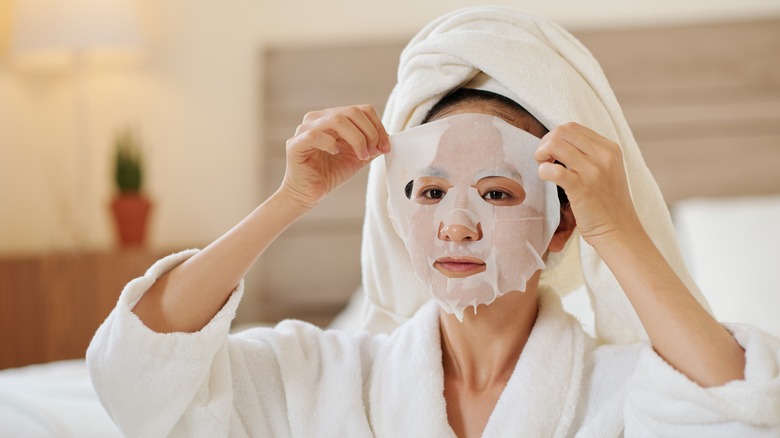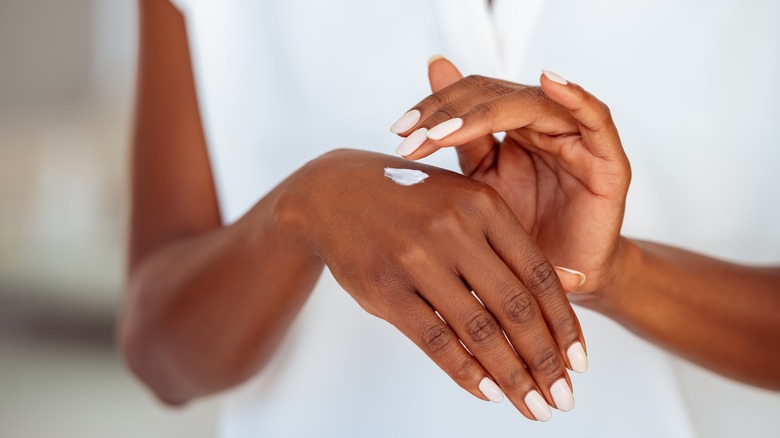Facial Sheet Masks Serve Double Duty As Body Moisturizers If You Use Them Right
Sheet masks are almost synonymous with self-care these days. While traditional mud masks still have a place in our hearts, sheet masks make it easy to add a touch of luxury to your skincare routine. Plus, the K-beauty staples have numerous benefits beyond their soothing properties; they often include potent compounds to target specific skin issues. "Using [sheet masks] can facilitate deeper penetration of [active] ingredients as the mask itself creates a barrier that keeps them from evaporating," board-certified dermatologist Fatima Fahs tells Forbes.
Of course, there's just one small problem that accompanies even the best sheet masks. Although there's nothing worse than a dry mask, many of them come with far more product than you can possibly use on your face. Any beauty lover can attest to the plight of opening a sheet mask only to be met with a veritable sea of serum. But fear not, sheet mask fans: That leftover fluid can double as the perfect body moisturizer to soothe your dry skin. Ahead, we'll explore some expert-approved ways to make your mask multitask.
Choosing the right sheet mask for your skin type
Today, there are many varieties of sheet masks to choose from — just look at the shelves of your local pharmacy or beauty store for proof. Still, you should always be on the lookout for products that are the right fit for your skin type. Many masks designed for facial use can be great for treating concerns on the body, as well. For example, suppose you have bumpy skin on your arms, also known as keratosis pilaris. In that case, you should choose a mask containing therapeutic ingredients like urea or glycolic acid. "My favorite products for keratosis pilaris involve keratolytics — ingredients that can break up that excess keratin build up — such as alpha-hydroxy acids, like lactic acid and glycolic acid," Dr. Dendy Engelman told Refinery29. Apply your sheet mask as you usually would and smooth the excess serum on the appropriate areas of your body.
Many people follow a skin cycle method and employ a specific type of mask each day, depending on the state of their complexion. Therefore, you can optimize your mask usage by choosing masks with ingredients to simultaneously target problem areas on your face and body. If you're unsure how your skin will react to sheet masks, look for unscented masks containing sensitive skin ingredients. Furthermore, you can make your own sheet masks if you still struggle to find suitable products. Simply purchase pre-cut sheet masks and infuse them with soothing ingredients like aloe, oatmeal, or yogurt.
How to amp up the moisture in your body treatments
Sometimes, it can feel like serum alone isn't enough for parched skin. If you're looking to add more moisture to your sheet mask treatment, why not try body slugging? "Skin slugging is simply the application of an occlusive to act as a barrier to seal moisture into the skin," board-certified dermatologist Jessie Cheung tells Healthline. "Dermatologists have been recommending [it] for years as the last step in your skincare routine to treat dry skin, as we know that skin slugging helps prevent water loss."
An occlusive is any moisturizing product that has the ability to lock in moisture, like petroleum jelly or cocoa butter. After you apply your sheet mask's serum, smooth on a heavy moisturizer to provide a boost of hydration. You can also wear cotton gloves or socks to keep things neat and extra-moisturized while performing hand or foot treatments. Body slugging can certainly provide you with softer, smoother skin, but it's best to include this extra step sparingly to avoid clogged pores.


